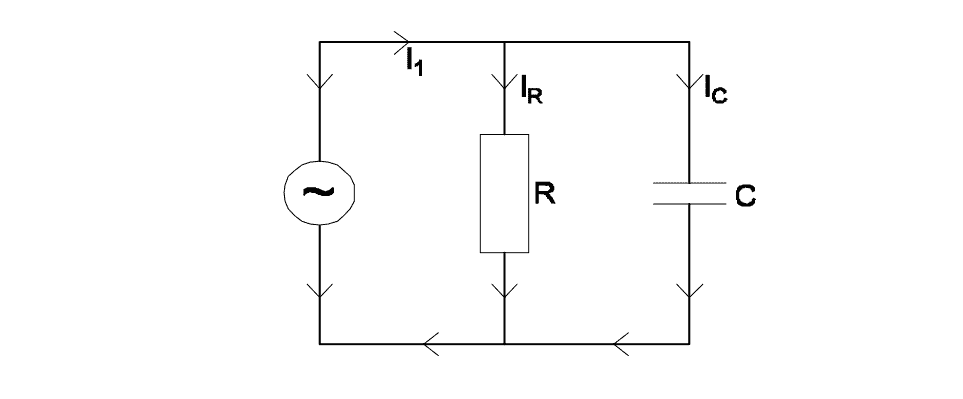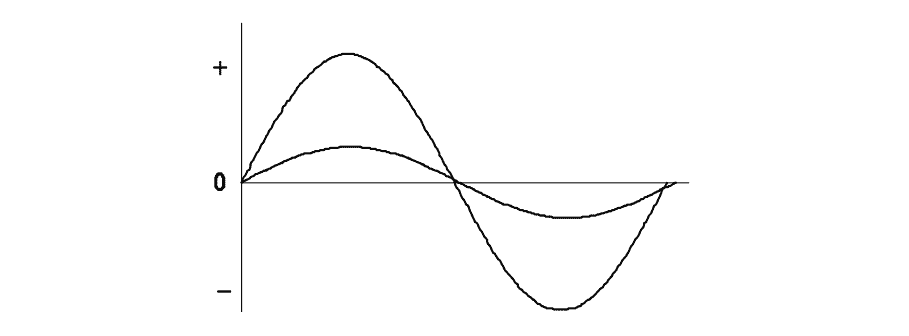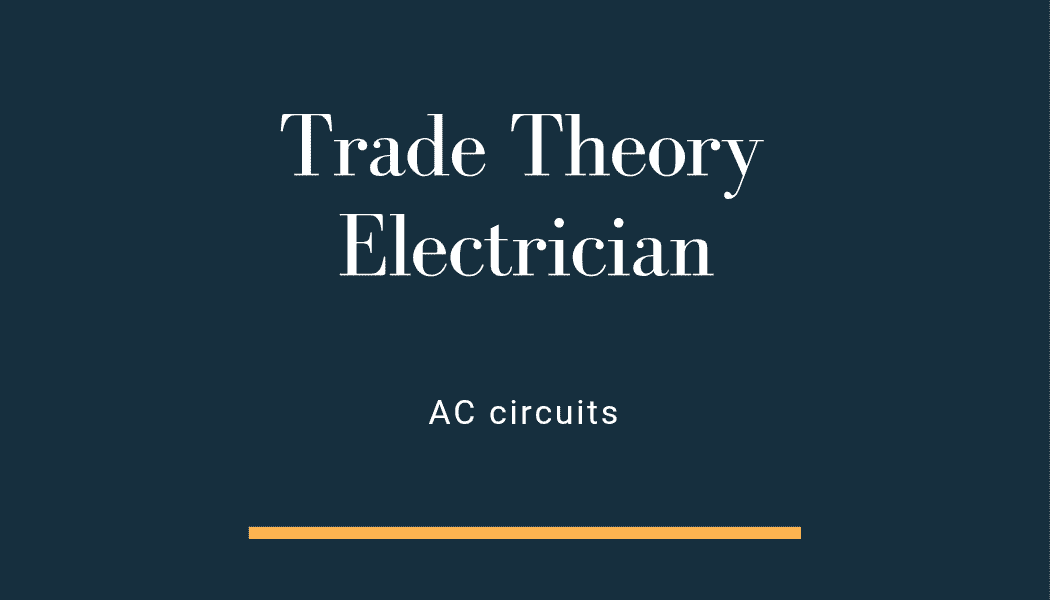AC Circuits
Electrician Trade Theory, Module-6
AC Circuits
⭕️ Show all Answers
Q1: What is the unit of susceptance?
- Mho
- Ohm
- Henry
- Farad
Q2: What is the resistance of the inductive coil takes 5A current across 240V, 50Hz supply at 0.8 power factor?
- 48 \(\Omega\)
- 42.5 \(\Omega\)
- 38.4 \(\Omega\)
- 26.6 \(\Omega\)
Show Calculation
Given:\[ V = 240\,\text{V}, I = 5\text{A},\cos\theta = 0.8\]\[ Real Power~ P = VI \cos\theta\]\[ = 240 \times 5 \times 0.8 = 960\,\text{W}\]\[ Resistance ~R = \frac{P}{I^2} = \frac{960}{5^2} = \frac{960}{25} = 38.4\,\Omega\]
Q3: How the resonance frequency \((f_r)\) can be increased in A.C series circuit?
- Increasing the inductance value
- Reducing the capacitance value
- Increasing the capacitance value
- Increasing the value of resistance
Q4: What is the formula to find 3 phase Reactive power \((P_R)\) if the line voltage is \(V_L\) and line current is \(I_L\)?
- \(P_r\) = \(V_L\) \(I_L\)
- \(P_r = \sqrt{3} V_L\) \(I_L\) cosθ
- \(P_r = \sqrt{3} V_L\) \(I_L\)
- \(P_r\) = \(V_L\) \(I_L\) sinθ
Q5: What is the main cause for below 0.5 lagging power factor in 3 phase system?
- Due to fluctuation of voltage
- True power due to resistive load
- Reactive power due to more inductive load
- Reactive power due to more capacitive load
Q6: What is the current in neutral conductor in 3 phase unbalanced load in star connected system?
- No current will flow
- The algebraic sum of current in 3 phases
- The algebraic sum of current in 2 phases only
- Lesser than the lowest current in any one of the phases
Q7: Calculate the apparent power in KVA of 3 phase 415V, 50 Hz, star system, if the line current \((I_L)\) is 16A at 0.8 power factor.
- 15.2 KVA
- 11.5 KVA
- 9.2 KVA
- 5.3 KVA
Show Calculation
Given:\[Line ~Voltage ~V_L = 415\,\text{V}, Current ~I_L = 16\,\text{A}\]\[ Power~ Factor ~\cos\theta = 0.8\] \[Apparent ~Power ~S = \sqrt{3} V_L I_L \]\[= \sqrt{3} \times 415 \times 16 \approx 1.732 \times 415 \times 16\]\[ = 11487.68\,\text{VA} = 11.5\,\text{KVA}\]
Q8: What will be the readings of two watt meters \((W_1\) & \(W_2)\) in 3 phase power measurement, if the power factor is zero?
- \((W_1\) & \(W_2)\) both are positive reading
- \(W_1\) is Positive and \(W_2\) is negative reading
- \(W_1\) is equal to \(W_2\) but with opposite signs
- Zero \(W_1\) is Positive reading, and \(W_2\) is negative reading
Q9: What is the maximum value of voltage for 240 volt RMS?
- 240V
- 415V
- 339.5V
- 376.8V
Show Calculation
Given: RMS Voltage \(V_{rms} = 240\,\text{V}\)Maximum Voltage \(V_{max} = \sqrt{2} \times V_{rms} = \sqrt{2} \times 240\) \[\approx 1.414 \times 240 = 339.36\,\text{V}\]
Q10: What is the condition for resonance in RLC series circuit? (Inductive reactance = \(X_L\), Capacitive reactance = \(X_C\))
- \(X_L\) > \(X_C\)
- \(X_L\) < \(X_C\)
- \(X_L\) = \(X_C\)
- \(X_L\) > \(\sqrt{2} X_C\)
Q11: What is the formula for Reactive Power \((P_r)\) in an AC circuit?
- \(P_r\) = VI
- \(P_r\) = \(\sqrt{2}\) VI
- \(P_r\) = VI cosθ
- \(P_r\) = VI sinθ
Q12: Calculate the impedance of the circuit R = 5Ω, \(X_L\)= 36Ω and \(X_C\) = 24 Ω.

- 69 Ω
- 65 Ω
- 13 Ω
- 12 Ω
Show Explanation
Given: \(R = 5\,\Omega\), \(X_L = 36\,\Omega\), \(X_C = 24\,\Omega\)Net Reactance \(X = X_L - X_C = 36 - 24 = 12\,\Omega\)
\[Impedance ~Z = \sqrt{R^2 + X^2} \]= \(\sqrt{5^2 + 12^2} = \sqrt{25 + 144} = \sqrt{169} = 13\,\Omega\)
Q13: What is the phase displacement in a single phase AC circuit?
- 90°
- 120°
- 180°
- 270°
Q14: What is the relation between the line voltage \((V_L)\) and phase voltage \((V_p)\) in star connected system?
- \(V_L = \sqrt{3} V_P\)
- \(V_L = 3 V_P\)
- \(V_L = V_P\)
- \(V_L = \frac {V_P}{\sqrt{3}}\)
Q15: Calculate the line current of the 3 phase 415V 50 HZ supply for the balanced load of 3000 watt at 0.8 power factor is connected in star.
- 8.5 A
- 5.2 A
- 4.5 A
- 3.4 A
Show Explanation
\[ Given: P = 3000\,\text{W}, V_L = 415\,\text{V}, \cos\theta = 0.8\] \[I_L = \frac{P}{\sqrt{3} \times V_L \times \cos\theta}\]\[ = \frac{3000}{\sqrt{3} \times 415 \times 0.8} \approx \frac{3000}{574.28} = 5.22\,\text{A}\]Q16: What is the power factor in a 3 phase power measurement of two wattmeters showing equal readings?
- 0
- 1
- 0.5
- 0.8
Q17: Calculate the power factor of coil having resistance of 24Ω, draws the current of 5A, at 240V/ 50Hz AC supply.
- 0.8
- 0.6
- 0.5
- 0.3
Show Calculation
\[ Given: R = 24\,\Omega, I = 5\,\text{A}, V = 240\,\text{V}\] \[ Apparent ~Power S = VI = 240 \times 5 = 1200\ \text{VA}\] \[ Real Power ~P = I^2 R = 5^2 \times 24\]\[ = 25 \times 24 = 600\,\text{W}\] \[ \cos\theta = \frac{P}{S} = \frac{600}{1200} = 0.5\]Q18: What is the formula to calculate the impedance (Z) of the R.L.C series circuit, if the inductive reactance \((X_L)\) is less than capacitive reactance \((X_C)\)?
- \(Z = \sqrt{R^2 + X_L^2 + X_C^2}\)
- \(Z = \sqrt{R^2 + (X_C - X_L)^2}\)
- \(Z = \sqrt{R^2 + (X_L - X_C)^2}\)
- \(Z = R + X_L + X_C\)
Q19: Calculate the power factor of R.L.C circuit having resistance (R) = 15Ω, resultant reactance (X) = 20Ω connected across 240V /50Hz AC supply?
- 0.5
- 0.6
- 0.7
- 0.8
Show Calculation
\[ Given: R = 15\,\Omega, X = 20\,\Omega\] \[Impedance Z = \sqrt{R^2 + X^2} = \sqrt{15^2 + 20^2} \]\[ = \sqrt{225 + 400} = \sqrt{625} = 25\,\Omega\] \[\cos\theta = \frac{R}{Z} = \frac{15}{25} = 0.6\]Q20: Calculate the value admittance (Y) of the RLC parallel circuit connected across 240volts/50Hz AC supply and 8 Amp. Current is passed through it?
- 3.33 Mho
- 0.33 Mho
- 0.033 Mho
- 0.003 Mho
Show Calculation
\[ Given: V = 240 \text{V}, I = 8 \text{A}\] \[Admittance ~Y = \frac{I}{V} = \frac{8}{240} = 0.0333\,\text{Mho}\]Q21: What is the formula to calculate the line current \((I_L)\) of this single phase R - C parallel circuit?

- \(I_L = I_R - I_C\)
- \(I_L = I_R + I_C\)
- \(I_L = \sqrt{I_R^2 + I_C^2}\)
- \(I_L = \sqrt{I_C^2 + I_{RL}^2}\)
Q22: How the low power factor (P.F) can be improved in AC circuits?
- By connecting resistors in series
- By connecting capacitors in series
- By connecting inductors in series
- By connecting capacitors in parallel
Q23: What is the formula to calculate the three phase active power (P) if the line voltage (VL) and line current is \(I_L\) and phase angle is ‘θ’?
- \(P = \sqrt{3} V_L I_L \sin\theta\)
- \(P = \sqrt{3} V_L I_L\)
- \(P = \sqrt{3} V_L I_L \cos\theta\)
- \(P = V_L I_L \sin\theta\)
Q24: What is the relation between the line current \((I_L)\) and phase current \((I_P)\) in delta connected system?
- \(I_L = I_P\)
- \(I_L = 3 I_P\)
- \(I_L = \sqrt 3 I_P\)
- \(I_L = \frac{I_P} {\sqrt 3}\)
Q25: What is the purpose of phase sequence meter?
- To control the speed of 3 phase motor
- To protect motor against short circuit fault
- To indicate the incorrect phase sequence of 3 phase
- To ensure the correct phase sequence of 3 phase system
Q26: Calculate the apparent power of a star connected 3 phase load, if it is connected across 3 phase 415volt/50Hz supply at 0.8 p.f and the phase current is 10 Amps.
- 12.45 KVA
- 57.50 KVA
- 3.320 KVA
- 7.188 KVA
Show Calculation
\[ Given: V_L = 415\,\text{V}, I_P = 10\,\text{A}, Star system\] \[Line ~current~ in ~star = Phase~ current = 10 \text{A}\] \[ Apparent ~Power ~S = \sqrt{3} V_L I_L \]\[= \sqrt{3} \times 415 \times 10 = 7188.8\,\text{VA} = 7.188\,\text{KVA}\]Q27: What is the P.F if one of the wattmeters reading is zero and the other reads total power in 2 wattmeter method of 3 phase power measurement?
- 0.5
- Zero
- Unity
- Below 0.5
Q28: Which electrical term is defined as the total opposition to current in AC parallel circuit?
- Resistance
- Impedance
- Admittance
- Susceptance
Q29: Which AC circuit contains the phase relation between voltage (V) and current (I)?

- Pure resistive circuit
- Resistance and inductance circuit
- Resistance and capacitance circuit
- Resistance, inductance and capacitance circuit
Q30: In a 3 phase system, if the active power is 4 kw and the apparent power is 5 KVA, calculate the reactive power?
- 1 KVAR
- 2 KVAR
- 3 KVAR
- 4 KVAR
Show Calculation
\[ Given: P = 4\,\text{KW}, S = 5\,\text{KVA}\] \[ Reactive Power Q = \sqrt{S^2 - P^2} = \sqrt{5^2 - 4^2} \]\[= \sqrt{25 - 16} = \sqrt{9} = 3\,\text{KVAR}\]Q31: In which condition resonance will occur in R-L-C series circuit?
- Inductive reactance \((X_L)\) is zero
- Inductive reactance \((X_L)\) is equal to capacitive reactance \((X_C)\)
- Inductive reactance \((X_L)\) is greater than capacitive reactance \((X_C)\)
- Inductive reactance \((X_L)\) is less than capacitive reactance \((X_C)\)
Q32: How will you obtain positive reading in the wattmeter reads negative reading during 3-phase two wattmeter method?
- By interchanging the connections of input terminals
- By disconnecting the connection of current coil in meter
- By reversing the connection of pressure coil in meter
- By reversing the pressure coil and current coil connection in meter
Q33: What is the form factor \((K_f)\) for sinusoidal AC?
- 1.00
- 1.11
- 2.22
- 4.44
Q34: What is the reciprocal of inductance in AC parallel circuit?
- Reactance
- Admittance
- Conductance
- Susceptance
Q35: What relationship is illustrated in between the current and voltage?

- Current and voltage are “in phase”
- Current and voltage are in out of phase
- Current lags behind the voltage
- Current leads ahead of the voltage
Q36: Calculate the total power by two wattmeter \((W_1\) & \(W_2)\) method, if one of the wattmeter \((W_2)\) reading is taken after reversing.
- \(W_1\) x 2
- \(W_1 only\)
- \(W_1 - W_2\)
- \(W_1 + W_2\)
Q37: In which 3 phase system, the artificial neutral is required to measure the phase voltage?
- 3 wire star connected system
- 4 wire star connected system
- 3 wire delta connected system
- 4 wire delta connected system
Q38: What is the line voltage in 3 phase system if the phase voltage is 240V?
- 380 Volt
- 400 Volt
- 415 Volt
- 440 Volt
Show Calculation
\[ Given: V_P = 240\,\text{V}\] \[ Line Voltage in star: V_L = \sqrt{3} \times V_P\]\[ = 1.732 \times 240 = 415.68\,\text{V} \approx 415\,\text{V}\]Q39: Which formula is used to calculate Form factor \((K_f)\)?
- \(K_f = \frac{Effective ~value}{Average ~value}\)
- \(K_f = \frac{Maximum ~value}{Effective~ value}\)
- \(K_f = \frac{Maximum~ value}{Average~ value}\)
- \(K_f = \frac{Average ~value}{Effective ~value}\)
Q40: Which formula is used to calculate the impedance (z) of a RLC series circuit?
- \(Z = R + X_L + X_C\)
- \(Z = R + (X_L + X_C)\)
- \(Z = R - (X_L \sim X_C)\)
- \(Z = \sqrt{R^2 + (X_L \sim X_C)^2}\)
Q41: What is the power factor if one of the wattmeter gives negative reading in two wattmeter method of 3 phase power measurement?
- 0
- 0.5
- Unity
- Less than 0.5
Q42: What is the phase displacement between phases in a 3 phase circuit?
- 90°
- 120°
- 180°
- 360°
Q43: Which condition is called as resonance RLC circuit?
- \(X_L\) > \(X_C\)
- \(X_C\) > \(X_L\)
- \(X_L\) = \(X_C\)
- R < \(X_L\)
Q44: Which quantity is rotating at a constant angular velocity?
- Scalar quantity
- Vector quantity
- Phasor quantity
- Algebraic quantity
Found a mistake or mismatch in the question or answer? Let us know via email.
This post is licensed under CC BY 4.0 by the author.
